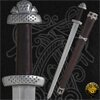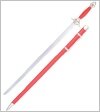|
|
|
PRODUCTS MANUFACTURED BY:
|
|
|
|
|
|
|
|
|
|
|
 |
|
| Hanwei Tinker Great Sword of War (SH2424) |
Points: 15


|
The Great Sword of War is designed and crafted purely as a cutting sword and, weighing a little less than four pounds, it is built to excel on heavy targets.
|
|
|
|
|
|
 |
|
| Hanwei Tinker Longsword Replacement Blade - Sharp (OH2396) |
Points: 5

|
This sharp Longsword blade may be used either to replace severely worn blades of the cutting sharp Tinker Longsword (Product No. HN-SH2394) or to convert the blunt sparring version of the Tinker Longsword (Product No. HN-SH2395) to a sharp weapon.
|
|
|
|
|
|
 |
|
| Hanwei Tinker Pearce Early Viking Sword - Blunt (SH2409) |
Points: 10


|
While not a direct copy of any particular sword, the Viking sword design was inspired by historical examples from the early 9th century, most notably finds from Trondheim, Norway, where the circular indentation hilt decoration was popular.
|
|
|
|
|
|
 |
|
| Hanwei Tinker Pearce Early Viking Sword - Sharp (SH2408) |
Points: 10


|
Early Medieval Sword designed by Michael `Tinker` Pearce and reproduced by Hanwei to his specifications.
The swords meet Tinker`s exacting quality requirements and are built in much the same way as his custom pieces. Each blade is forged from 5160 Spring Steel, Marquenched to the desired hardness of 50-53 Hrc while the tang is drawn back to the low 30s Hrc. The very end of the tang is threaded to fit an allen nut recessed into the pommel which allows for dimantling of the hilt assembly for inspection or to exchange blades if needed.
|
|
|
|
|
|
 |
|
| Hanwei Tinker Pearce Norman Sword - Blunt (SH2427) |
Points: 10


|
The Tinker Norman sword pair, with their distinctive cruciform guard and brazil-nut pommel, are similar in weight and static balance and offer virtually identical handling characteristics. Both are harmonically balanced, optimizing the handling characteristics for the re-enactor in the case of this blunt version.
|
|
|
|
|
|
 |
|
| Hanwei Tinker Pearce Norman Sword - Sharp (SH2426) |
Points: 10


|
The Tinker Norman sword pair, with their distinctive cruciform guard and brazil-nut pommel, are similar in weight and static balance and offer virtually identical handling characteristics. Both are harmonically balanced, optimizing cutting ability in the case of this sharp version.
|
|
|
|
|
|
 |
|
| Hanwei Torino Main Gauche (SH2207) |
Points: 8
|
Based on models of 17th century swept-hilt rapiers of Italian ancestry, our Torino Rapier and matching Main Gauche exhibit the classic straight crossguard styling popular in this part of Europe. Available in antiqued(SH2204N), polished(SH2204), and now left-handed polished(SH2204L) versions.
All of our rapiers have stainless steel hilts, for reduced maintenance, and high-carbon steel flex-tempered blades. Our three swept-hilt styles (Solingen, Torino, Gustav) are available with hilts in both polished and antiqued finishes. The latter finish, developed by Hanwei, has allowed a museum-quality patina to be applied to stainless steel while the non-corroding properties of the steel are retained. This finish is extremely attractive and gives a very authentic appearance to the piece.
|
|
|
|
|
|
 |
|
| Hanwei Torino Main Gauche (antiqued) (SH2207N) |
Points: 8
|
Based on models of 17th century swept-hilt rapiers of Italian ancestry, our Torino Rapier and matching Main Gauche exhibit the classic straight crossguard styling popular in this part of Europe. Available in antiqued(SH2204N), polished(SH2204), and now left-handed polished(SH2204L) versions.
All of our rapiers have stainless steel hilts, for reduced maintenance, and high-carbon steel flex-tempered blades. Our three swept-hilt styles (Solingen, Torino, Gustav) are available with hilts in both polished and antiqued finishes. The latter finish, developed by Hanwei, has allowed a museum-quality patina to be applied to stainless steel while the non-corroding properties of the steel are retained. This finish is extremely attractive and gives a very authentic appearance to the piece.
|
|
|
|
|
|
 |
|
| Hanwei Torino Rapier (antiqued) (SH2204N) |
Points: 15
|
Based on models of 17th century swept-hilt rapiers of Italian ancestry, our Torino Rapier and matching Main Gauche exhibit the classic straight crossguard styling popular in this part of Europe. Available in antiqued(SH2204N), polished(SH2204), and now left-handed polished(SH2204L) versions.
All of our rapiers have stainless steel hilts, for reduced maintenance, and high-carbon steel flex-tempered blades. Our three swept-hilt styles (Solingen, Torino, Gustav) are available with hilts in both polished and antiqued finishes. The latter finish, developed by Hanwei, has allowed a museum-quality patina to be applied to stainless steel while the non-corroding properties of the steel are retained. This finish is extremely attractive and gives a very authentic appearance to the piece.
|
|
|
|
|
|
 |
|
| Hanwei Trondheim Viking (SH2296) |
Points: 40

|
Hanwei continues to push the envelope with its forging capability in the Trondheim sword, produced as a one-piece forging in pattern-welded high-carbon steel. Patterned after swords that have been discovered in the area around Trodheim, Norway, the sword exhibits early ninth-century styling, a time when the Norwegian Vikings were pillaging Britain and Ireland. The beauty of the blade is matched by the grip and scabbard, both of which are wrapped in top-grain leather, engraved in a classic Viking motif.
|
|
|
|
|
|
 |
|
| Hanwei Water Song Wushu Broadsword (SH2064) |
Points: 8
|
The Water Song Wushu Broadsword (SH2064) has an ultra-flexible high-carbon blade, tapering to almost paper-thin at the tip. At barely a pound in weight, the sword is very quick and the Water Song (caused by vibrating the blade) is very audible.
|
|
|
|
|
|
 |
|
| Hanwei Wind & Thunder Wakizashi (SH5024) |
Points: 24
|
Wind & Thunder Wakizashi by Hanwei. This new cutting wakizashi from CAS/Hanwei is designed specifically for the martial artist that needs a sword for the demands of rigorous tameshigiri. The Wind & Thunder features a heavier and thicker blade with traditional furniture and fittings. The Wind & Thunder is fitted with the black iron Raiden tsuba and Tomoe motif fuchi and kashira. The handle is wrapped in genuine same (ray skin) and the tsuka-ito is premium Japanese black cotton. The saya is done in a traditional black laquer and the sageo is also black cotton. This sword is an excellent choice for those intereseted in batto-jutsu.
Thick & Heavy Blade
Hand-forged High Carbon Steel Blade
Great for Tameshigiri
|
|
|
|
|
|
 |
|
| Hanwei Wushu Flexible Tai Chi Sword (SH2062) |
Points: 5
|
In response to requests from Wushu practitioners for swords with ultra-flexible blades, we have developed the Flexible Long Sword. With a spring steel blade tapering to almost paper thin at the tip, it is very light (barely one pound), extremely fast and surprisingly loud in skilled hands. A tassel (Item SH2078) is available separately.
Highly flexible
Very light and quick
|
|
|
|
|
|
|
Tags:
martial arts, katana, iaito, sword, fencing, tonfa, boken, bokken, kama, shinai, samuraj, judo, karate, kenjutsu, kenjitsu, ninja, kungfu,
|
















